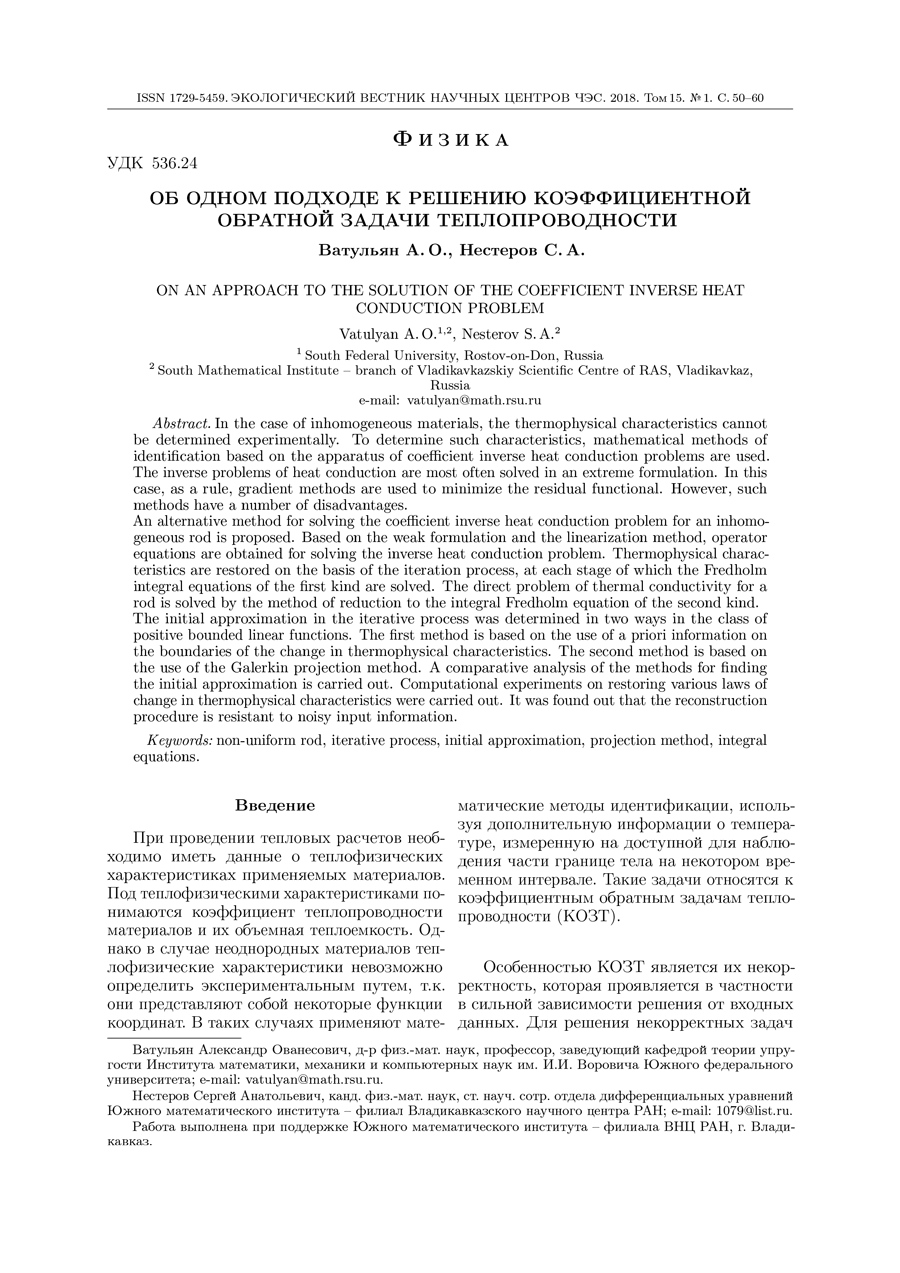On an approach to the solution of the coefficient inverse heat conduction problem
UDC
536.24DOI:
https://doi.org/10.31429/vestnik-15-1-50-60Abstract
In the case of inhomogeneous materials, the thermophysical characteristics cannot be determined experimentally. To determine such characteristics, mathematical methods of identification based on the apparatus of coefficient inverse heat conduction problems are used. The inverse problems of heat conduction are most often solved in an extreme formulation. In this case, as a rule, gradient methods are used to minimize the residual functional. However, such methods have a number of disadvantages. ewline An alternative method for solving the coefficient inverse heat conduction problem for an inhomogeneous rod is proposed. Based on the weak formulation and the linearization method, operator equations are obtained for solving the inverse heat conduction problem. Thermophysical characteristics are restored on the basis of the iteration process, at each stage of which the Fredholm integral equations of the first kind are solved. The direct problem of thermal conductivity for a rod is solved by the method of reduction to the integral Fredholm equation of the second kind. ewline The initial approximation in the iterative process was determined in two ways in the class of positive bounded linear functions. The first method is based on the use of a priori information on the boundaries of the change in thermophysical characteristics. The second method is based on the use of the Galerkin projection method. A comparative analysis of the methods for finding the initial approximation is carried out. Computational experiments on restoring various laws of change in thermophysical characteristics were carried out. It was found out that the reconstruction procedure is resistant to noisy input information.
Keywords:
non-uniform rod, iterative process, initial approximation, projection method, integral equationsAcknowledgement
References
- Alifanov, O.M., Artukhin, O.M., Rumyantsev, S.V. Extreme methods for solving ill-posed problems. Nauka, Moscow, 1988. (In Russian)
- Denisov, A.M. Introduction to the theory of inverse problems. MSU, Moscow, 1994. (In Russian)
- Vatulyan, A.O. Inverse problems in mechanics of deformable solids. Fizmatlit, Moscow, 2007. (In Russian)
- Kravaris, C., Seinfeld, J.H. Identification of spatially varying parameters in distributed parameters systems by discrete regularization. J. of Mathematical Analysis and Applications, 1986, vol. 119, pp. 128-152. DOI: 10.1137/0323017
- Chen, W.L., Chou, H.M., Yang, Y.C. An inverse problem in estimating the space - dependent thermal conductivity of a functionally graded hollow cylinder. Composites. Part B, 2013, vol. 50, pp. 112-119.
- Kabanikhin, S.I., Hasanov, A., Penenko, A.V. A gradient descent method for solving an inverse coefficient heat conduction problem. Numerical Anal. Appl., 2008, no. 1, pp. 34-45. DOI: 10.1134/S1995423908010047
- Hao, D.N. Methods for inverse heat conduction problems. Peter Lang, Frankfurt/Main, 1998.
- Isakov, V., Bindermann, S. Identification of the diffusion coefficient in a one dimensional parabolic equation. Inverse Problems, 2000, no. 6, pp. 665-680.
- Raudensky, M., Woodbary, K.A., Kral, J. Genetic algorithm in solution of inverse heat conduction problems. Num Heat transfer B, 1995, vol. 28, pp. 293-306.
- Danilaev, P.G. Coefficient inverse problems for parabolic type equations and their applications. VSP, Utrecht, Boston, Koln, Tokyo, 2001.
- Lam, T.T., Yeeng, W.K. Inverse determination of thermal conductivity for one-dimensional problems. J. of Themophys. Heat Transf., 1995, vol. 9, no. 2, pp. 335-342.
- Xu, M.H., Cheng, J.C., Chang, S.Y. Reconstruction theory of the thermal conductivity depth profiles by the modulated photo reflectance technique. J. of Appl. Physics, 2004, vol. 84, no. 2, pp. 675-682.
- Vatul'yan, A.O., Nesterov, S.A. A Method of Identifying Thermoelastic Characteristics for Inhomogeneous Bodies. J. of Engineering Physics and Thermophysics, vol. 87, no. 1, pp. 225-232 (2014). DOI: 10.1007/s10891-014-1004-6
- Nedin, R., Nesterov, S., Vatulyan, A. On an inverse problem for inhomogeneous thermoelastic rod. Int. J. of Solids and Structures, 2014, vol. 51, no. 3, pp. 767-773. DOI: 10.1016/j.ijsolstr.2013.11.003
- Nedin, R., Nesterov, S., Vatulyan, A. On reconstruction of thermalphysic characteristics of functionally graded hollow cylinder. Appl. Mathematical Modelling, 2016, vol. 40, no. 4, pp. 2711-2719. DOI: 10.1016/j.apm.2015.09.078
- Nedin, R., Nesterov, S., Vatulyan, A. Identification of thermal conductivity coefficient and volumetric heat capacity of functionally graded materials. Int. J. of Heat and Mass Transfer, 2016, vol. 102, pp. 213-218. DOI: 10.1016/j.ijheatmasstransfer.2016.06.027
- Tikhonov, A.N., Goncharsky, A.V., Stepanov, V.V., Yagola, A.G. Numerical methods for solving ill-posed problems. Nauka, Moscow, 1990. (In Russian)
Downloads
Submitted
Published
How to Cite
Copyright (c) 2018 Vatulyan A.O., Nesterov S.A.

This work is licensed under a Creative Commons Attribution 4.0 International License.




